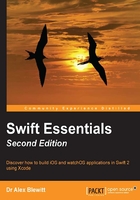
Conventions
In this book, you will find a number of text styles that distinguish between different kinds of information. Here are some examples of these styles and an explanation of their meaning.
Code words in text, database table names, folder names, filenames, file extensions, pathnames, dummy URLs, user input, and Twitter handles are shown as follows: " "hello".hasPrefix("he") method compiles and runs successfully on OS X and iOS."
A block of code is set as follows:
> var shopping = [ "Milk", "Eggs", "Coffee", ]
shopping: [String] = 3 values {
[0] = "Milk"
[1] = "Eggs"
[2] = "Coffee"
}
When we wish to draw your attention to a particular part of a code block, the relevant lines or items are set in bold:
func setupView() {
contentMode = .Redraw
}
New terms and important words are shown in bold. Words that you see on the screen, for example, in menus or dialog boxes, appear in the text like this: "Xcode documentation can be searched by navigating to Help | Documentation and API Reference."
Note
Warnings or important notes appear in a box like this.
Tip
Tips and tricks appear like this.